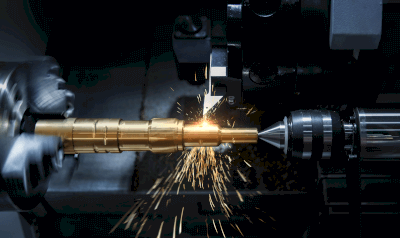What Is Turning?

Turning is a machining process where a cutting tool, often referred to as a bit, shapes a rotating workpiece on a lathe. This process is commonly known as lathe turning, is used to produce symmetrical objects with tools chosen based on the desired outcome.
Uses of Turning
Turning excels in producing cylindrical products such as screws, bolts, shafts, and nipples. Its versatility allows for complex shapes through various bits and precise surface specifications by adjusting the rotation speed. Turning is indispensable in manufacturing precision components for devices like smartphones and automotive parts.
Principle of Turning
The process involves securing a cylindrical workpiece on a lathe and cutting its periphery and sides with a high-speed rotating tool. Selecting the right tool is crucial for achieving the desired shape and dimensions. Efficiency and quality in turning depend on balancing lathe speed, spindle speed, and the bit’s depth. Adjustments to these parameters influence machining time, accuracy, and tool longevity. Moreover, setting the correct depth of cut is essential to prevent defects caused by excessive cutting heat and frictional resistance.
Types of Turning
1. Perimeter Machining
This method focuses on shaping the outer circumference of a workpiece, encompassing techniques like outer rounding, step cutting, taper cutting, curved surface cutting, grooving, butt cutting, and knurling.
2. End-Face Machining
End-face machining targets the workpiece’s end, involving end face grinding, front face grinding, and chamfering.
3. Drilling
Drilling involves creating holes, either by pressing a drill against the workpiece’s end face for initial drilling or enlarging an existing hole’s diameter through boring.
4. Screw Machining
Also known as threading, this process creates threads along a workpiece’s periphery or within a hole, including external and internal threading.
5. Profile Machining
Using profile-specific turning tools, profile machining cuts even complex shapes efficiently, according to predefined specifications.
Other Information on Turning
1. Types of Bits
Turning operations utilize various bits, including single-edge, sword, thrusting, threading, knurling, and rotary tools, each designed for specific tasks like shaping external forms, cutting through workpieces, threading, knurling, and more.
2. Structural Classification of Bits
Bits are categorized based on their structure into disposable, brazed, and solid types.
- Disposable Bits: Feature replaceable cutting edges for easy maintenance without the need for regrinding.
- Brazed Bits: With brazed cutting edges, these bits are durable, suitable for rough machining but require time-consuming regrinding.
- Solid Bits: Made from a single piece of material, these bits, also known as solid or finished bits, require regrinding once dull.
3. Chip Shape
The shape of chips produced during turning, such as flow, shear, swell, and cracked types, provides insights into the machining process’s efficiency and potential issues, guiding adjustments for optimal outcomes.